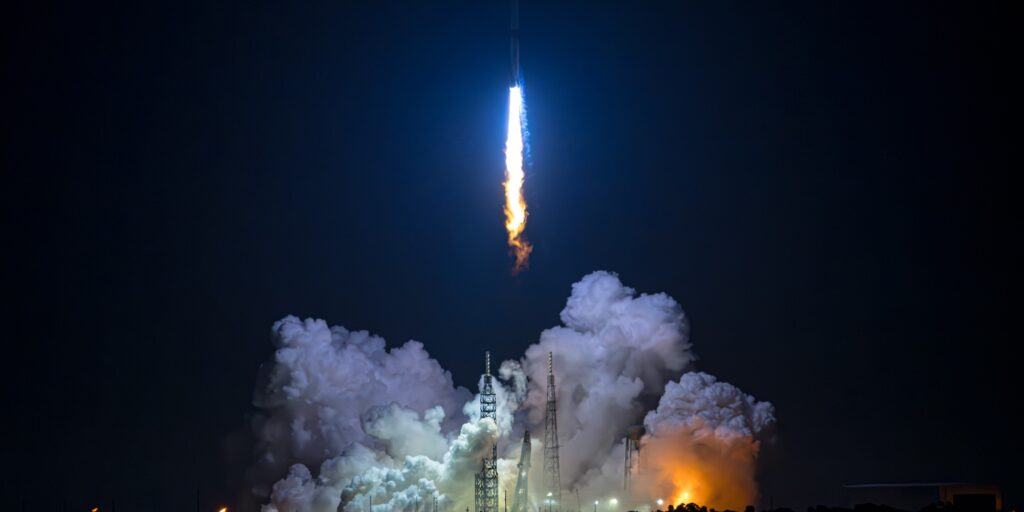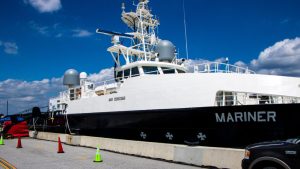
New Glenn at liftoff during the NG-1 mission, Jan. 16, 2025. (Photo: Blue Origin)
WASHINGTON — Blue Origin, the space launch company founded by billionaire Jeff Bezos almost 25 years ago, successfully tested its New Glenn heavy-lift rocket for the first time early this morning — lofting the company’s Blue Ring Pathfinder demonstration spacecraft to orbit in partnership with the Pentagon’s Defense Innovation Unit (DIU).
But there’s no doubt Space Force hearts have also been lifted by the simple fact of New Glenn’s testing success, as service leaders see the launch vehicle as a future competitor to SpaceX’s Falcon series rockets that currently have a lock on the most critical launches under the Defense Department’s National Security Space Launch program.
The giant two-stage New Glenn rocket — named after astronaut John Glenn — can carry more than 13 metric tons to geostationary transfer orbit (from whence the spacecraft will make its own way to geosynchronous Earth orbit) and 45 metric tons to low Earth orbit. It performed as expected, but the reusable first stage failed to make its landing on Blue Origin’s capture ship called “Jackyln” after Bezos’s mother. Nonetheless, the NG-1 test mission is being hailed both inside and outside the company as a success.
“I’m incredibly proud New Glenn achieved orbit on its first attempt,” said Blue Origin CEO Dave Limp in a press release today. “We knew landing our booster, So You’re Telling Me There’s a Chance, on the first try was an ambitious goal. We’ll learn a lot from today and try again at our next launch this spring.”
Clay Mowry, CEO of the American Institute of Aeronautics and Astronautics that advocates for the space industry, echoed Limp’s assessment.
“Today’s New Glenn test flight from Cape Canaveral Space Force Station marks a pivotal moment in heavy-lift reusable launch vehicle development. The team has made tremendous technical progress reaching orbit on this first attempt,” he said.
And one happy DoD official summed up: “They did great.”
Blue Origin hopes to move quickly to get through two certification flights to be able to compete for the NSSL Phase 3 program’s so-called Lane 2, which covers launches of critical payloads and those to more difficult to achieve orbits.
At the moment, SpaceX’s Falcon 9 and Falcon Heavy are the only two launch vehicles certified for those launches.
While United Launch Alliance (ULA) made the second certification launch of its Vulcan Centaur on Oct. 4, a nozzle on one of the solid rocket boosters fell off. So far, the Space Force has yet to sign off the company’s effort to fix the problem and gain NSSL Lane 2 approval.
Meanwhile, on Jan. 5, DIU announced that it is moving forward with three prototype contracts under its Orbital Logistics Vehicle Project to:
Blue Origin with the Blue Ring platform, which is demonstrating a “heavy utility m-OLV [multi-orbit logistics vehicle] capable of transporting (hosting) one or more mechanically-coupled payloads or spacecraft (500+kg payload capacity)” via the Blue Ring Pathfinder and Dark-Sky-1 mission payloads;
Northrop Grumman’s Space Logistics, which is providing a “suite of in-space refueling technologies,” including its “Active Refueling Moule (ARM) and Passive Refueling Module (PRM);” and
Spacebilt (formerly Skycorp), which was awarded a contract “for further validation of their approach In Space Assembly and Manufacturing for enabling their m-OLV product for DoD use cases.”





